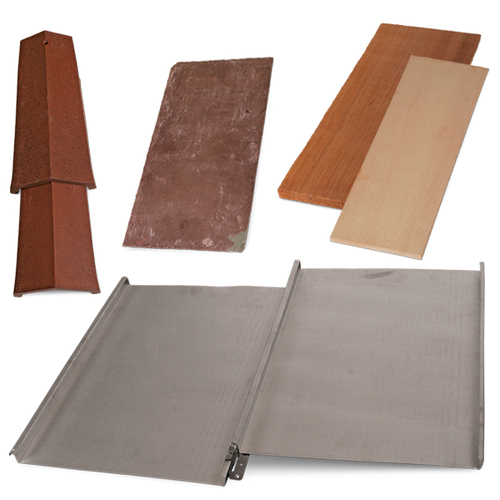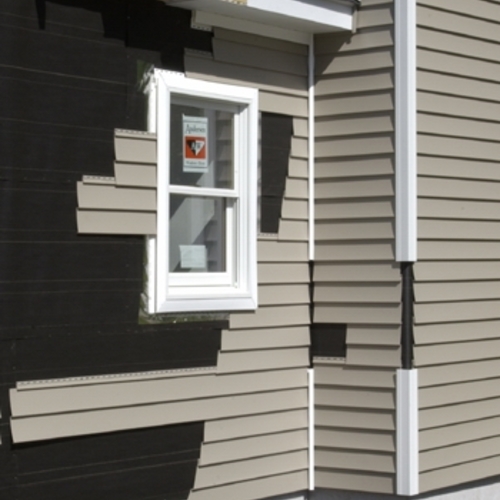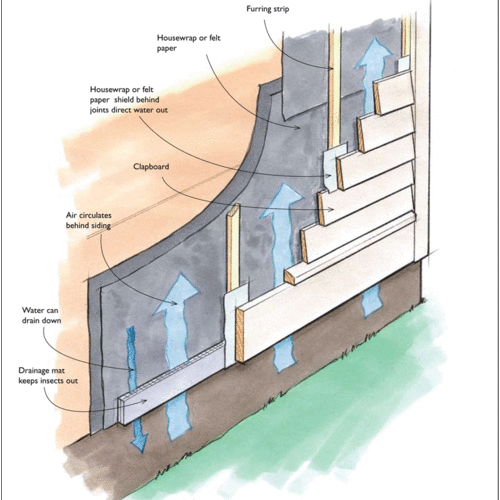ABOUT SIDING
Durable, low-maintenance siding is best
Durable siding requiring little maintenance is the appropriate choice for a green home.
Siding is an important architectural feature. There are half a dozen major families of siding, and many variations within those categories. Some are strong regional favorites, either because they are well suited to the climate or because they have a long local history (usually both).
In addition to durability, criteria for choosing siding include cost, maintenance requirements, ease of installation, and environmental impact.
ABOUT RAINSCREENS
Stopping rain that gets past the siding
Even the best cladding will fail if it is installed improperly. The performance of all of the materials listed above depends on the quality of installation, including the water-resistive barrier, flashing, and back-venting (or rainscreen) details that allow the siding to dry properly from the back. (For more information on WRBs, see All About Water-Resistive Barriers.)
In most cases, the investment in a rainscreen siding installation pays dividends in paint longevity and siding durability.
Vinyl siding is inherently well ventilated and always has air behind it. Brick veneer, if installed according to code requirements, always includes a ventilated air space between it and the sheathing. Neither vinyl siding nor masonry veneers needs a rainscreen.
Siding without a rainscreen
Other types of siding — wood clapboard, cedar shingles, fiber-cement — are often fastened tight to the sheathing with no intervening air space. Such installations can perform well, especially in a dry climate or on a wall that is protected by a wide roof overhang. But such installations are less forgiving than rainscreen installations, and often experience premature paint failure. If one or two things go wrong, walls without a rainscreen can trap moisture and begin to rot. For more information on what can go wrong if a wall is poorly detailed, see All About Wall Rot.
When stucco is installed on a wood-framed wall, a rainscreen is always recommended. For more information on stucco installation, see To Install Stucco Right, Include an Air Gap.
To create a rainscreen, first install a layer of asphalt felt or housewrap over the sheathing. The wrap must be carefully integrated with window and door flashing. For horizontal siding like wood clapboards or fiber-cement, an air space can be created by installing vertical strapping over each stud. A variety of materials can be used for strapping, including 1×3 lumber, rips of 1/4-inch plywood, or plastic battens.
For panel siding, cedar shingles, or stucco, create an air space with a three-dimensional plastic mat (for example, Cedar Breather) or a plastic dimple sheet.
For more information on rainscreen installations, see All About Rainscreens.
Bird’s-Eye View

Image Credits: Daniel S. Morrison/Fine Homebuilding
Your first defense against the weather
Siding has both decorative and functional purposes, but some of the options come with a heavy environmental price tag. Choose a durable product that is low in toxicity and can be manufactured sustainably. The layers you don’t see, such as housewraps, drainage mats, and insulated sheathing panels, are just as important for durability and weatherization. Getting siding details right may be the most important step in creating a durable home — especially where roofs, decks, and porches make penetrations.
See below for:
Wood

Image Credits: Dan Thornton/Fine Homebuilding #177
Local wood is a green choice
Wood siding, a first choice in some regions, is easy to work with, nontoxic, and completely biodegradable, depending on its finish. Some species are maintenance-free, but most need regular coats of paint. Back venting wood siding can make the paint last longer.
The greenest wood siding is harvested sustainably.
Stucco

Image Credits: Don Mannes/Fine Homebuilding #162
Stucco and synthetic stucco
are extremely durable wall finish materials, as long as they are installed with details to handle moisture intrusion. Exterior insulation and finish system (EIFS), also called synthetic stucco, is a modern alternative to stucco that combines a polymer cladding with a substrate of polystyrene insulation.
Brick

Image Credits: Don Mannes/Fine Homebuilding #142
Insects are not a concern, but moisture is
Low-maintenance, highly durable brick veneer is also fire- and insect-resistant. As with stucco, brick veneer needs to be installed with details that are designed to address moisture intrusion.
Stone

Image Credits: Dan Thornton/Fine Homebuilding #192
Stone and synthetic stone
Facing a wood-framed building with stone or synthetic stone is a good way to get the look of traditional masonry at a lower cost than traditional construction methods. Both materials are fire- and insect-resistant, need very little maintenance, and are among the most durable wall claddings available — as long as flashing and moisture details are well thought out and executed.
Fiber cement

Image Credits: Roe A. Osborn/Fine Homebuilding #140
Durable, but the details of its manufacture are controversial
Fiber-cement (cementitious) siding has some real durability advantages but isn’t the easiest type to install. Two of fiber cement’s ingredients raise a few environmental concerns — Portland cement, due to the energy required by its production, and wood fiber, due to sourcing and transportation costs — but almost every home already includes them. Some manufacturers are using alternative components that make their products greener.
Vinyl

Image Credits: Tom O’Brien and David Ericson/Fine Homebuilding #149
Vinyl: Loved and hated
Homeowners love it for its low maintenance requirements and modest installation cost, and vinyl siding performs extremely well from a moisture-management perspective. But it has the same environmental drawbacks as other products made from polyvinyl chloride (PVC).
OTHER CONSIDERATIONS
Plan for wetness
Getting siding details right may be the most important step in creating a durable home. All siding types leak, but leaks may also occur where siding abuts other building materials, such as roofing or a masonry chimney. Potential trouble areas include any penetration through a wall, such as at windows, doors, decks, porches or additions. The installation of the layers you don’t see behind the siding, such as housewraps, drainage mats, and insulated sheathing panels, are just as important for durability and weatherization.
GREEN POINTS
LEED–H MR2.2 (Materials & Resources) offers 1/2 point for environmentally preferable siding, including FSC, salvaged, and recycled-content options; 1/2 point more if it is locally sourced.
NGBS Under Chapter 6, “Resource Efficiency”: weather-resistive barrier (WRB mandatory (602.9); up to 6 points for insect-resistant materials (602.8); up to 2 points for siding that does not require site-applied finish (601.7); up to 8 points if siding contributes as a bio-based component (606.1).











2 Comments
Does air space lower R- value?
"For panel siding, cedar shingles, or stucco, create an air space with a three-dimensional plastic mat (for example, Cedar Breather) or a plastic dimple sheet"
If we create an air space between stucco and sheathing wouldn't it lower the R - value of stucco?
Response to Anonymous
Anonymous,
Stucco has no appreciable R-value. Moreover, an air space can add to the R-value of the wall assembly -- about R-1 additional.
Log in or create an account to post a comment.
Sign up Log in